COMANCHE COUNTY KSGENWEB 2008: HISTORY & GENEALOGY
HOME
Bibliography
Biography
Cemeteries
Churches
Cities & Towns
Clubs
Contributors
Diamond Jubilee
Events
FAQ
Genealogy
Guest Book
History
Links
Maps
Military
News Articles
Newspapers
Opry
Photos
Poetry
Records
Satellite Images
Schools
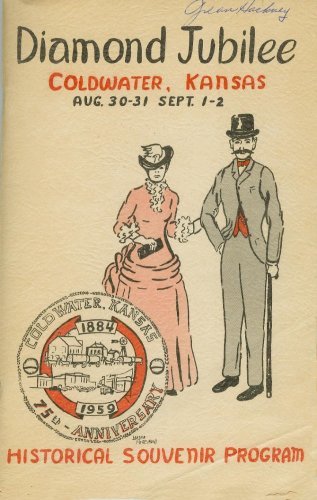
Diamond Jubilee
Historical Souvenir Program,
Coldwater, Kansas,
Aug. 30 - Sept. 2, 1959.
At left: Front Cover artwork: Coldwater Diamond Jubilee Committee. Diamond Jubilee, Coldwater, Kansas, Aug. 30-Sept. 2, 1959. Historical Souvenir Program. Coldwater, KS: Western Star, 1959.
The copy of the booklet shown at left belonged to Jean Hackney and is from the collection of Robert Hackney. Thanks to Bobbi (Hackney) Huck for having furnished the information & images on this webpage.
Please be patient while your computer downloads the many large image files for this web page. If you're using a dial-up connection with a 56K modem, be prepared to wait a few minutes to be able to see all the images on this page. If some images don't download on your 1st attempt, then refresh the page and allow all the images to download before you start scrolling down the web page.
Although Bobbi provided each and every word and image contained in the original booklet for me, not all of them - due to webmastering time constraints - appear on this web page.
-- Jerry Ferrin
=========== Inside Front Cover ==========
DIVISIONS: 1)ARTICLES 2) PAGEANT 3)PAGE SPONSORS 4) ADVERTISERS 5) PHOTOS(not in ads)
Index Diamond Jubilee Souvenir Program 1959
inside front cover: Business & Professional Women
inside back cover: The Coldwater Lions Club
articles
2
1. Foreword
1. Permanent Townsite Selected
1. Historical Comanche County Coming of the Railroad
2. The Hardest Years
4. Many Streams in the County
4. Wheat Becomes Important
6. Coldwater's Newspapers, Charles M. Bean
8. Early Day Sod House
8. Chris Nickelson
8. Coldwater National Bank
10. Cattle Industry in Comanche County
12. Ghost Towns
14. The Coldwater Schools
18. The People's State Bank
20. County Hospital History
22. The Fradulent Bonds
24. The County Post Offices
26. C.F. Biddle
26. Early Methodist Church
28. History of Assembly Of God
28. William Henry Knecht
30. Christian Church History
30. Davis T. McIntire
30. Howard R. Burnett
34. History of The Friends Church
36. Antioch Church History
36. John W. Stark
38. Presbyterian Church History
38. First Child Born Here
40. Wilmore History
42. Memorial Rose Garden
44. The Farm Bureau
46. Brief History of Protection
48. History of Comanche Pool
49. Mr. and Mrs. W.V. Jackson Memorial Page
50. Coldwater District Library
51. Gregg Ranch, Mr. & Mrs. Philo Gregg
52. Early-Day Ranches
52. Joseph Taylor
53. Frank Dodson; Mr. and Mrs. E.T. Dodson Pioneer Citizens family
55. Edward and Ella Deewall In Memory Of
56. Mrs. Frank King
56. James Samuel Hudson
57. Mr. and Mrs. Jacob Kurz
58. David F. Edmonds
58. New Town of Greensburg
59. Mr. and Mrs. Wm Oller In Memory Of
60. A.H. Baker
62. Comanche County's Mormon Colony
62. John Todd
63. William Kimple
63. George Henry Torrey
64. Sophia E. Holmes
======================================================
Pageant of The Prairie Synopsis
32. Prologue and Episode 1-5
33. Episode 6-14 and Final Episode
===========================================================
Page sponsors:
1. The Western Star
4. Frank E. Daily, JR.
6. Ronald McCoy, M.D. and Harold S. Herd
22. Sponsored by "The Three Jacks" Jack Wilkerson, Jack Vance, Jack Ferguson
26. Dr. H.S. Schulz, Herman Schulz, Edith Sunderland-Schilz, Jay T. Botts, Clyde A. Blount
49.Dan N. Jackson and Charles R. Jackson
51. Mr. & Mrs. Muriel Gregg; Mr. & Mrs. Charles Gregg; Mr. & Mrs. Donald Booth
53. Frank Dodson; Mr. and Mrs. Harry B. Cloud
55. The Deewall Family
57. Rose Oller, Ethel Mae Swaim, Mable Parker
59. By the Five Oller Children
64. By Six Holmes Bible Study Clubs
============================================================================
Advertisers
3. Comanche Lodge No. 295 A. F. & A. M.
5. Allerdice's Department Store
3. Job's Daughters
3. Order of The Eastern Star
3. Comanche County Shrine Club
7. Western Light & Telephone Company
9. John H. Paul Insurance
9. Rural Gas & Electric Company Bill Wasinger
9. The Coldwater National Bank
10. Lazy D Hereford Ranch - George W. Deewall
11. New Eden Polled Herefords - Mr. and Mrs. Mark Brown & Son
12. Parker Beeley Ranch - Mable Parker - R.W. and Dorothy Beeley
13. John and Laura McMoran Hereford Cattle
13. Brass Oil Company
13. Ralph D. Barnhart, Florist
13. Motel Vermillion and Grocery - Norman Hadley
14. Alvin J. Eckert: Painting, Paper Hanging, Tile Setting
15. Coldwater Sales Company, Inc. - Livestock Auction
16. Whitzel Insurance and Wallpaper - Lester and June Whitzel
16. C.C. Peterie - Transporter for Liquid Fuels
16. Marjorie's Beauty Shop - Marjorie Overocker
17. Van Vranken Oil Company
17. Anderson's Cree-Mee Drive In - Fred and Martha Anderson
18. Copple & Lytle John Deere Farm Machinery - Dwight Copple & Lowell Lytle
19. The People's State Bank
20. Northside Food Market - Toby, Ruby, Joe and Jerry
21. Gilchrst Oil Company
21. Gilchrist Lumber Company
23. The Cudahy Packing Company, Wichita, Ks
23. Southwestern Bell Telephone Company - Sam Hamrick, Mgr.
23. Woolwine's, Pratt, Ks
24. Coca-Cola Bottling Company, Dodge City, Ks
24. Lemon Truck Service - Luther Lemon
25. Home Lumber & Supply Company Yards
27. Joyce's Dress Shop - Joyce Copple
27. Hoofer's Red & White - Bill and Ralph Hoofer
27. Beauty Bar - Denton and Bonnie Frazier
27. King Abstract Company - Fred and Leda King
28. Herd's Standard Service - Bill Herd
29. Auto Electric - W.N. Willie Parsons
29. Independent Oil - Frank McMillin Mgr.
29. B.J. Herd Motor Company - B.J. and Bessie Herd
31. Wolcott & Lincoln Inc. - Clinton Sherman, Mgr.
31. Gambles - Myrl and Lena Haun
31. Comanche County Farm Bureau Assn. - Robert Sanders
34. Coldwater Laundry & Dry Cleaners - Mr. and Mrs. John Kittell
35. Steffens Ice Cream
35. The Protection Co-op Supply Co.
36. Vaughn Coles: Grocery, Gas and Oil in Buttermilk - Vaughn and Elaine
37. Gwen's Shop - Gwen and Clair Thompson
37. Sam P. Wallingford Grain Corp. - Darrell Smith Mgr.
38. Burton Drug Co. - Victor P. Burton
39. Coldwater Lockers - H. L. Northern
39. The Pike Hotel - C.W. and Dorsya Dale
39. The Coldwater Co-operative Oil Company - Lutzie H. Poltera Mgr.
40. Wilmore State Bank, Wilmore
41. Bowersock Mills & Power Co., Wilmore
41. Boorn's Grocery - Harry and Leona Boorn, Wilmore
41. Godfrey Isenbart - In Memory Of (sponsored by Margaret Isenbart-Morris)
41. Charles E. Baker, SR. - In Memory Of (sponsored by Mrs. C.E. Baker)
42. City Cleaners - Milton and Icle Nokes
43. Hatfield Furniture - Charles and Beth Hatfield
43. Orr Hardware - Kate Orr & E. L. Orr
44. Peterson Motor Sales - Laurel Peterson
44. Morrison-Gregg-Mitchell Grain Company
45. Hack's Pleasure Club - George Hackney
45. Lem's Package Store - Lemuel Herd
46. Filson Manufacturing Company, Protection
47. The Farmer's State Bank, Protection
47. Bill's Grocery - Bill Schultz, Protection
47. Davis Plumbing & Heating, Protection
47. Hopkins Repair Shop, Protection - Tommy Hopkins
48. Williams Service - Winston (Tiny) Williams
48. Art's Repair Service, Blacksmithing and Welding - Arthur Hough
50. Coldwater Motor Co. Ford
50. Chief Theatre - Porter and Betty Smith
52. Howard Brass, Wilmore, Selling Livestock, Real Estate, Farm Sales
52. The Barber County Building & Loan Association - L. G. Whitzel
52. Greensburg Production Credit Association - J.B. Woods Mgr.
54. E & W Cafe - Winnie Hall and Edna Williams
56. Davis & Razak Engineers, Dodge City, Ks
56. "Chuck Wagon Cafe" - Clyde, Evelyn and Johnny Wayne Pugh
58. Fairmont Foods Company, Dodge City Ks
58. American Legion, Comanche Post No. 122, American Legion Auxiliary
60. The Carey Salt Company, Hutchinson Ks
61. Hecht's Produce - C.A. Hecht
61. Taylor & Son Insurance
61. White's IGA Grocery - Joe and Francis White
61. Willard's Ben Franklin - Victor abd Barbara Willard
62. Warren's Dept. Store - Warren and Mozelle Bransom
62. John G. Allen, DVM
63. Coldwater Paint & Body Shop - Harry Nicholsen
63. Thornton Trucking - Ernest E. Thornton
=========================================================================
Photos:
inside front cover: Coldwater BPW
1. Board of Directors of Diamond Jubilee 1959
2. Looking North on Central circa 72 yrs. ago
6. Threshing on the Albert Oller farm in 1916
8. One of the first Sod Houses in Comanche County
14. Coldwater's First High School Building Built in 1889
18. 1904-05 County Officers
20. Comanche County Hospital
22. Early-Day Fourth Of July Celebration In Coldwater
26. Methodist Church
28. Assembly Of God Church
30. Christian Church
34. Friends Church
36. Antioch Church
38. Presbyterian Church
40. Alpha Hotel At Wilmore
42. Train Brings Needed Harvest Hands To Save The Wheat Crop
46. 1910 picture of Protection Boosters and Band Looking North on Main Street in Protection
49. Mr. and Mrs. W.V. Jackson
51. Mr. and Mrs. Philo Gregg
53. Mr. and Mrs. E.T. Dodson
53. Frank Dodson
54. Cowboys Employed by the Comanche Pool
55. Mr. and Mrs. Edward Deewall (Ella)
57. Mr. and Mrs. Jacob Kurz
59. Mr. and Mrs. Wm Oller
60. Early Day Parade Picture on Coldwater's Main Street
62. Part of the Coldwater Grade and High School Buildings, 1958
64. Sophia E. Holmes
Inside back cover: Coldwater Lions Club
COLDWATER BUSINESS & PROFESSIONAL WOMEN'S CLUB WELCOMES YOU
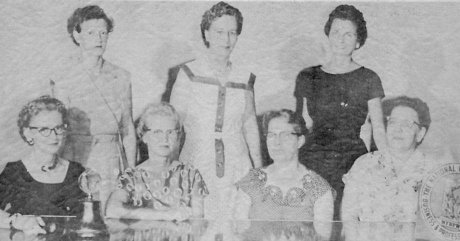
1959-1960 OFFICERS
Seated: left to right: Ruby Booth. President; Leola Wilkerson, First Vice President; Wilma Lewis, Second Vice President; Helen King, Corresponding Secretary.
Standing, left to right: Dorothy Stewart. Treasurer; Myrtle Clinesmith, Recording Secretary; June Whitzel, State Legislative Steering Committee Chairman.
PAST PRESIDENTS
| Mary Carlton | 1941-42 | | CHARTERED in 1941-42 |
| Floy Grace | 1942-43 | | 33 Charter Members |
| Mabel Eaton | 1943-44 | | |
| Pearl Gerhart | 1944-45 | | Members as of |
| Ruth Bird | 1945-46 | | August 7, 1959: 70. |
| Marie Swisher | 1946-47 | | |
| Jessie Chamness | 1947-48 | | CHARTER MEMBERS |
| Icle Nokes | 1948-49 | | STILL ACTIVE: |
| Victoria Flowers | 1949-50 | | |
| Martha Anderson | 1950-51 | | Helen Deewall |
| Lottie Mills | 1951-52 | | Mabel Eaton |
| Frances Harrow | 1952-53 | | Pearl Gerhart |
| Norma Harp | 1953-54 | | Mary Guyer |
| June Whitzel | 1954-55 | | Lottie Mills |
| Leda King | 1955-56 | | Anna Pennington |
| Dorothy Guss | 1956-57 | | |
| Alice Bean | 1957-58 | | |
| Leona Butcher | 1958-59 | | |
=========== Page 1 ==========
FOREWORD
A sincere effort has been made to picture an authentically as possible a true story, necessarily condensed, of the history of Coldwater and Comanche County. Old files and records have been consulted and interviews with old-timers have added to the information given.
Thanks to the hundreds of citizens who have given of their time and effort to make this community project one long to be remembered.
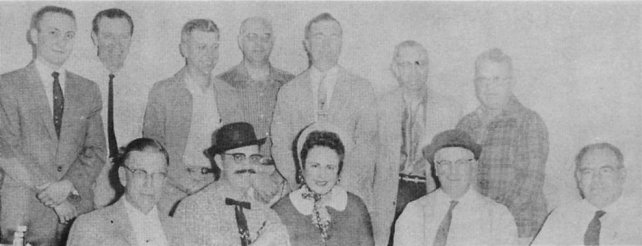
Board of Directors and committee chairmen: standing, from the left: Richard Jackson, Harold Herd, chmn.; John Paul, James Herrington, L.G. Whitzel and M.E. Haun. Seated from the left: Horace Rich, Norman Butcher, Mrs. Leslie Mills, Victor Allerdice, treas.; and Harry Craig, secy.
PERMANENT TOWNSITE SELECTED
From The Western Star, February 21, 1902
In May, 1884, a company of men, most of them from Harper County, Kansas, decided to go further west, with the view of locating a townsite which would ultimately become a county seat. While looking the county over and inspecting for a suitable location they happened to meet C.D. Bickford, who a short time before had come from Michigan and settled about three miles southwest of the present townsite of Coldwater. A compromise was effected with Mr. Bickford and it was decided to remove the town nearer to the center of the county. The city was to be called Coldwater after Mr. Bickford's native town, Coldwater, Michigan.
The town company was organized and they gave a lot to anyone who would erect a building not less than 14 by 16 feet. Lots went like hot cakes and carpenters were in demand. Lumber was hauled from Kinsley 50 miles north, then the nearest railroad point. Then began a veritable boom, not only in settling up of the city, but of the entire county.
The first marriage in Coldwater was of James B. Jones and Miss Sarah D. Beymer, September 16, 1884.
HISTORICAL COMANCHE COUNTY
Comanche County was organized in March 1885. George Norris, D.T. McIntire and Owen Connaughton were appointed as temporary County Commissioners and R.A. Crossman as temporary clerk.
The first election was held April 2, 1885, when Coldwater was chosen as the permanent county seat, receiving a majority of 383 votes. The following were elected as county officers:
County Attorney: William A. Templeman; County Clerk, Frank A. Holmes; Register of Deeds, John A. Pennington; Clerk of Court, Edmond B. Peel; Probate Judge, John D.F. Jennings; County Treasurer, Abraham Darroch; Sheriff, Emil Bowers; Supt. of Public Schools, James B. Curry; County Surveyor, E.P. Lee; Representative, Geo. W. Vickers; Coroner, P.C. Jay; County Commissioners, Owen Connaughton, A.D. Lee, Jesse Shimer; First Chairman, Owen Connaughton.
Comanche County was created by an act of the state legislature in 1867, which provided for the division into counties of all the unorganized part of the state east of the range line 26 west, and was named for the Comanche tribe of Indians. The act provided the following bounds for Comanche county, commencing where the east line of range 16 west, intersects the 6th standard parallel, thence south to the 37th degree north latitude, thence west to the east line of range 21, thence north to the 6th parallel,
=========== Page 2 ==========
thence east to the beginning. By political division it is bounded on the north by Kiowa, east of Barber County, south by the state of Oklahoma, and on the west by Clark County.
It's area is 695 square miles. Before the county could be organized, it was required by an act of June 4, 1861, that a census be taken including Indians not taxed and who are bonafide residents of the county and the United States.
Actual settlement was slow. The first real settlers entered land during the spring and summer of 1873 but only a few attempted farming. A number of cowmen took possession soon after the land was ceded to the Government by the Osage Indians and ranged thousands of cattle over this and adjoining counties. Some of the cowmen organized a company which became well known as the Comanche Pool. Very few men took up land for agricultural purpose until the spring of 1884, when a rush for the most desirable land began. This influx of homesteaders who broke and in many cases fenced their land, ended the career of the cowman and closed to them for all time a mighty empire of free range, resulting in a certain amount of friction between the cattleman and the homesteaders.
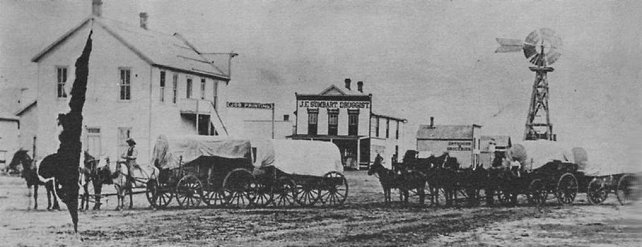
Looking North on Central circa 72 years ago
This era passed away with the going of the longhorn and then by the united cooperation of both factions of Comanche County was enabled to produce in millions rather in thousands. Not however without many hardships, sacrifices and even hunger. By the close of 1885 practically all the good claims in the county had been taken up. The majority of these pioneers were men of small means who came into the county to lay the foundations of their fortunes, to cope with the fickleness of nature and to change the desert into a land of promise and fields of waving gold and green.
To the women of Comanche County history must pay tribute. Shoulder to shoulder with the men they performed men's work. In every way they met the hardships confronting them. They assisted in building the homes in which their children were born and lived to see the prosperity of Comanche County reared as a monument to their dreams.
=========== Page 3 ==========
 COMANCHE LODGE NO. 295, A.F. & A.M.
COMANCHE LODGE NO. 295, A.F. & A.M.
COLDWATER, KANSAS
CHARTERED FEBRUARY 15, 1888
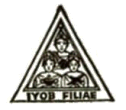
INTERNATIONAL ORDER OF JOB'S DAUGHTERS
Coldwater, Kansas
Bethel No. 44
Honored Queen.......................Marilyn Gregg
Senior Princess.....................Dolores White
Junior Princess.....................Clydean Bibb
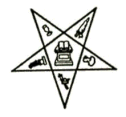
ORDER OF THE EASTERN STAR
Coldwater Chapter No. 224
Instituted October 14, 1899
Chartered May 11, 1900
Madeline McCulla..............Worthy Matron
Victor White......................Worthy Patron
Clyda Gregg.......................Secretary
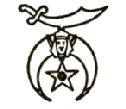
COMANCHE COUNTY SHRINE CLUB
Clair Thompson...............President
Norman Hadley...............Vice President
Harold Herd....................Secretary
F.H. Moberley.................Treasurer
=========== Page 4 ==========
THE HARDEST YEARS
When in the spring of 1882 the Cheyenne and Arapahoe country was thrown open the development of the county continued. In 1888 the assessors' report indicated a population of 5,636 while that of 1889 was only 2,498. Hard times came with the dry years from 1891 to 1897 when crops were either a complete failure or partially so, and retrogression of the county reached its climax in 1896 when the population fell to only 1269. During these years when the settlers were leaving fields untilled, homes were abandoned and property values depreciated. The so-called cattle barons fenced in all the land and ranged large herds at will over all the pasture land available. They paid light taxes and owned little land.
The many streams afforded fine water for the stock. Cattle brought good prices and these may be called the balmy days of the second generation of the cowman. Some had held the land for so long that they seemed to think they had an undisputable right to it. By their influence and activity in local politics they managed to secure the election to the principal county offices men who were friendly to their claims and the homesteaders who wished to locate in the county found everything against them.
This domination of the cattleman lasted until the 90's when gradually but surely the farmers began to gain in numbers and influence and resettlement by small land holders began in earnest in the spring of 1905.
MANY SPRINGS IN COUNTY
The general contour of the county is level except where the land breaks into bluffs along some of the larger streams. The valley and second bottom land are alluvial deposits and very fertile. The many streams are fringed with narrow belts of timber, chiefly cedar, walnut, elm and cottonwood. Sandstone, mineral paint and gypsum are plentiful while salt springs are numerous in the western portion. The Cimarron River flows southeast across the southwest corner of the county. Its principal tributaries in the county are Calvary and Bluff Creek which are in the western part. The eastern portion is well drained by the Mustang, Nescatunga, Indian and big Mule creeks, all of which are tributaries to the Salt Fork of the Arkansas River.
Geologic Map * Rocks and Minerals in the Red Hills * Red Hills *
Rocks & Minerals in the High Plains *
High Plains *
Land Cover *
Oil & Gas Production
*
Topographic Map
The city fathers have just passed an ordinance prohibiting haystacks within 300 feet of town.
WHEAT BECOMES IMPORTANT
The first sod to be broken in Comanche County was due to the demand of the pre-emption laws which required that the settler break out 10 acres of sod, presumably to show an intent to farm. Generally this land was planted to crops to feed livestock and to feed a hungry family.
Warren Morton informed the writer that he helped E.C. Sabin harvest wheat in 1892. In 1893 he worked with a steam threshing rig for several weeks and they threshed wheat and other small grain as far north as the present Kiowa County line.
In 1904 or 1905 four farmers south of Coldwater were among the first who planted wheat in larger acerage for a cash crop. John Stark planted 40 acres, Bill Oller planted 40 acres, Geo. Overocker planted 40 and Henry Knecht 40. When the crop came in for harvest there was no harvesting equipment available for harvesting wheat in sizable acreages. The four farmers purchased a new header in partnership and harvested their wheat by exchanging work with each other. After getting the wheat harvested and in the stack, their next problem was to get it all threshed. Mr. Metzger, the great-grandfather of Eddie Metzger, owned a horse power, hand fed threshing machine and was engaged to do the threshing for them.
The wheat was hauled to Coldwater in grain wagons, pulled by horses or mules. Perry Johnston weighed the wheat on his scales and it was scooped by hand into cars on the railroad. Mr. Johnston shipped it to Kansas City for them where there was a wheat market.
By 1910 or 1911 many of the settlers were interested in growing wheat and were breaking out sod in an earnest manner. This was the beginning of the end for many of the cattle ranchers. Land that could be farmed to wheat was now selling for $15.00 per acre. Much of this land had been bought for $1.50 per acre. Many of the ranchers were willing to take that kind of profit and were selling land.
Trouble between the cattle men and the farmers became acute at that time. The cattle men would allow several hundred head of cattle to break into a farmer's growing crops at night and by morning when they were discovered, there wouldn't be much of the crop left. Cole and Overstreet, cattlemen, were accused of much of this kind of
=========== Page 5 ==========
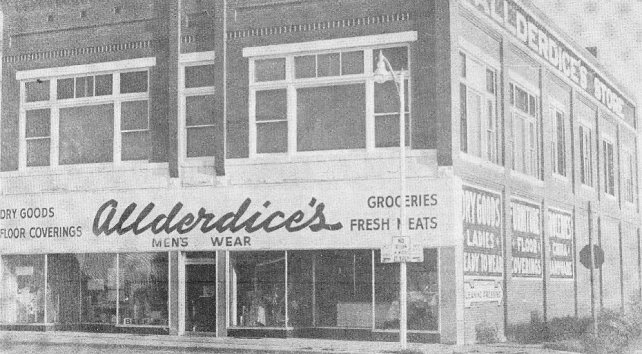
"A Complete Store At Your Door"
1892-1959
67 Years of Serving This Community
ALLDERDICE'S DEPARTMENT STORE
Phones LU 2-2164 and LU 2-2123 Coldwater, Kansas
=========== Page 6 ==========
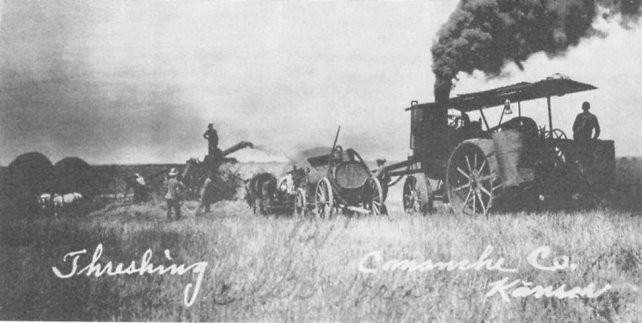
THRESHING ON THE ALBERT OLLER FARM IN 1916
trouble. According to Albert Oller, his father, Bill Oller, planted castor beans in or near his growing crops. When the expected cattle break-in occured, the cattle grazed the beans along with the other crops. Several head of the cattle died. This proved an effective measure for keeping the cattle out but was not at all popular with the cattle owners. Albert says that his father wore a six-shooter strapped on his hip when he planted castor beans.
Probably the biggest sod breaking movement occurred in 1916 and 1917. At that time wheat reached the record price of $3.00 to $4.00 per bushel. By this time binders and headers were common in Comanche County wheat fields. Huge steam threshing rigs were now threshing thousands of bushels of small grain per day.
COLDWATER NEWSPAPERS
On August 16, 1884, son after Coldwater was founded, John G. Cash of Lexington, Missouri, who had brought a Washington hand press and some type by wagon from Kinsley, printed Coldwater's first newspaper, The Western Star. Two months later he sold the paper to his brother Wm. M. Cash.
During the next 18 months, three other newspapers--The Record, The Review and The Republican--were started, each wanting to 'get in on' the $4 publication fee allowed for printing the filing notices of the many settlers who flocked to the county. When the Review discontinued, the Coldwater Signal took its place.
During the past 75 years the Star has not missed an issue and has been in only the Cash and Butcher families. Merle T. Butcher, Kingman editor, was associate editor of the Star 21 years. Ward H. Butcher and his son Norman W. Butcher, are continuing the business, which has been in the family 61 years.
When this era ended and the Oklahoma Strip opened for settlement, about two-thirds of the settlers left this county and most of the papers folded up. Later, however, the Echo and the Advocate were published here for several years.
After editing the Star 14 years, Mr. Cash sold his paper to H.V. Butcher, who also purchased and discontinued the Stock Journal, which had been published a number of years, principally in the interests of the cattleman.
In 1889, J. Lawton Stanley began the publication of The Talisman, Coldwater's seventh newspaper, and continued as editor until his death in 1940. Herman McIntyre published the paper until 1942, when he sold his subscription list to the Western Star.
CHARLES M. BEAN
Charles M. Bean was born September 6, 1853, in Iowa, and came to Comanche County in 1884, locating on government land 12 miles east of Coldwater. He was engaged in farming and
cattle raising, and prospered up to the time of his death in 1900, age 47.
=========== Page 8 ==========
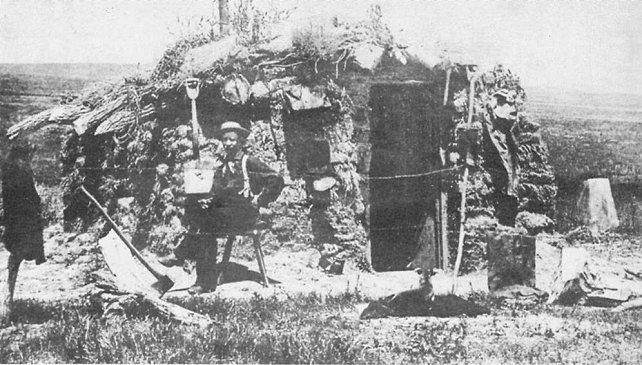
ONE OF THE FIRST SOD HOUSES IN COMANCHE COUNTY
EARLY DAY SOD HOUSES
The man sitting in front of Comanche County's first sod house is not identified, but it is said that he was a bachelor! Which is remindful of the jingle going the rounds of Western Kansas newspapers in the 1880's, "The Little Old Sod Shanty of the Claim," two stanzas of which are as follows:
'I am looking rather seedy now, while holding down my claim,
And my victuals are not always served the best;
And the mice play shyly 'round me as I nestle down to sleep,
In my little old sod shanty on the claim.
But when I left my Eastern home, a bachelor so gay,
To try to win my way to wealth and fame,
I little thought that I'd come down to burning twisted hay,
In my little old sod shanty on the claim.
CHRIS NICKELSON
Born in Germany in 1874 and came to this country with his parents in 1883. Came to Comanche County in 1884. He had always been a farmer and with many others of the early settlers, had his share of hard times in common with all. Also many prosperous days, and had participated much in the history and making of Comanche County. A man who was always upright in all walks of life and had the esteem of his fellow citizens.
COLDWATER NATIONAL BANK
The Coldwater National Bank succeeded the Comanche County State Bank which was organized during the summer of 1885 by Holmes and Company of Wellington, Kansas, with Fred Hurlbut as cashier.
A year later or so the bank changed hands and James A. Blair became the President and Boardman F. Smith, Vice-President. Later Mr. Smith became President. Associated with him were J.M. Lobaugh and W.S. Mussett. The bank was nationalized in 1903 and N.A. Lytle was elected cashier.
Victor J. Allderdice, President of the bank, became associated with the organization in 1916 and Thos. C. Mahan, Executive Vice President in 1917. J.H. Allderdice, Vice President, is inactive. James D. Herrington, cashier, joined the bank in 1951, Frances E. Harrow, assisitant cashier in 1948 and Jerry Allen, assistant cashier in 1955.
The present board of directors is: Victor J. Allderdice, Dan N. Jackson, Elsie E. Allderdice,
Helen Herrington, J.H. Allderdice, James D. Herrington, and Thos. C. Mahan.
The bank is a member of the Federal Deposit Insurance Corporation under certificate No. 4645.
The American Bankers Association, The Kansas Bankers Association, and the Federal Reserve System.
=========== Page 9 ==========
CATTLE INDUSTRY IN COMANCHE COUNTY
by: DAN N. JACKSON
The cattle industry in Comanche County is divided into three distinct periods. The first began in the late 1870's in the days of the open range and finished about 1886, when practically all of the country was homesteaded. Of the men of that period I had the privilege of knowing were George Overocker, John Bell, Dave McIntire, Chas. Colcord, Turk Rinehart, and Frank King, each of whom told me some very interesting stories of happenings of those days.
The second period began in the early 90's as the settlers who were able to leave abandoned their holdings. At that time men like M.R. Platt, Tom Curran, Frank Biddle, Al Hall and many others began building herds of cattle and using as much land as they could, leasing and buying land as they built their herds and ranches. This period ended about 1912-1915 and to a boy who rode his first horse to a roundup away from home in 1900 and has been interested in the cattle business ever since then, those were the days, maybe not so good but sure a lot of thrills and experiences that I would not trade for a million dollars.
The third period began during World War I and has not finished. It has been in some ways a series of boom and bust, highlighted by the depression of '29 and '30 and the drouth of the Dust Bowl days. Skyrocketing prices following World War II and the drop in cattle prices and drouth of the last few years are just a part of this stage of the cattle business.
I have seen a lot of changes in the kind and quality of cattle--the longhorned spotted C.G. of Garst and the wild and wooly Galloways of Platt to the present-day high quality Herefords and Angus that have given this country the reputation of the best feeder cattle in Kansas. There has been just as much change in the way cattle are handled. In 1906 we worked a bunch of cattle on Mustang Creek about a mile south of where my brother, Charles, lives, cut out the stuff to ship and nightherded them in a pasture north of where I live and drove them to Wilmore the next day and loaded that night. Just last week I was at Charley's place to get some dry cows. We drove a pick-up truck out and honked and two men followed the cows into the corrals. We sorted, weighed them, checked for brucellosis, tested and loaded them on trucks, all in a matter of a few hours' time.
=========== Page 10 ==========
Lazy D Hereford Ranch
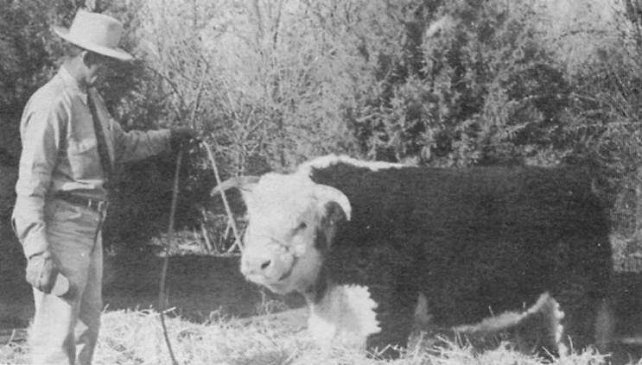
One of the typical herd bull types we have produced on our ranch located seven miles south of Coldwater on the highway.
 * REGISTERED HEREFORDS SINCE 1932
* REGISTERED HEREFORDS SINCE 1932
* HEIFERS ARE FOR SALE
* VISITORS WELCOME AT ALL TIMES AT THE RANCH
=========== Page 11 ==========
NEW EDEN POLLED HEREFORDS
- New Eden Polled Herefords, producing continually for 44 years in Comanche County.
- Home of the Kansas State Sale Champion Bull in November, 1958, at Hutchinson, Kansas.
- First place Junior Yearling and second highest selling bull in Oklahoma State Sale, December 12, 1958 at Enid, Oklahoma.
- First place Senior Yearling Bull and second highest selling bull at the Kansas Range Bull Sale at Norton, Kansas on March 16, 1959.

N.E.DON PERFECT 8th
Champion Bull at Hutchinson, November 18, 1959. Sold for $2,775.00
SIRES IN SERVICE:
G.P.H. DON PERFECT 24th O.M.S. MODEST LAD 9th
N.E. DON PERFECT 26th
Young Cattle for Sale at All Times
Mr. and Mrs. Mark G. Brown & Son
owners
Seven Miles East of Coldwater, Kansas on 160 Highway
PHONE 5-F-11 Wilmore, Kansas
=========== Page 12 ==========
GHOST TOWNS
In the early days of Comanche County 10 or 15 towns sprang up. One of the towns was called Evansville. It was on what is now called the Merrill Ranch, 20 miles southwest of Coldwater. A Mr. Campbell carried the mail every day from Coldwater to Evansville in a spring-wagon.
Even larger than Evansville was Comanche City, a town 15 miles south and 6 or 7 miles west of Coldwater. It was on what is now called the Clay Woolfolk ranch. It even had brick buildings and was at one time larger than either Protection or Coldwater.
Comanche City probably started in 1881 or 1882. It died when a proposed railroad from Anthony to Comanche City failed to materialize. Buildings from the town were moved to Coldwater and Protection. It had regular boom town history. The town of Avilla was 9 and one-half miles south of Coldwater and one-half mile west. Earl Guss was the first baby born there. They had a bad tornado the night before he was born, but it only tore things up and no one was hurt. The paper of Avilla said, 'Well, at least the tornado did some good. It brought Oliver Guss and wife a baby boy.'
Earl Guss went through his first years of school there at Avilla. It had two livery stables, a bank, two stores, blacksmith shop, and a paper. Steve Knecht was one of the store owners and it was on his porch one quiet summer evening they had a little excitement. A few men were sitting out in front of the store 'chipping' their teeth (talking), when two Dalton brothers rode boldly into town. With drawn guns the Dalton boys dismounted and robbed the men on the porch, and the store and after not getting very much, they robbed the post office too, but they still didn't get much. Then they made all the men stretch their hands clear up in the air, got them in the middle of Main street and told them to start running east. Since the farmers had no guns, they quickly obeyed. With all the men running east, the Dalton brothers calmly rode out of town west.
Plano was another settlement that became a ghost town in Comanche county. This town was just east of Comanche City, southeast of Protection, near the S.A. Ellsworth place. It was organized in 1884. John Keys moved it away after a dry summer. The town had a store and a post office run by C.H. Douglas of Protection, now of Denver, Colorado.
PARKER & BEELEY RANCH
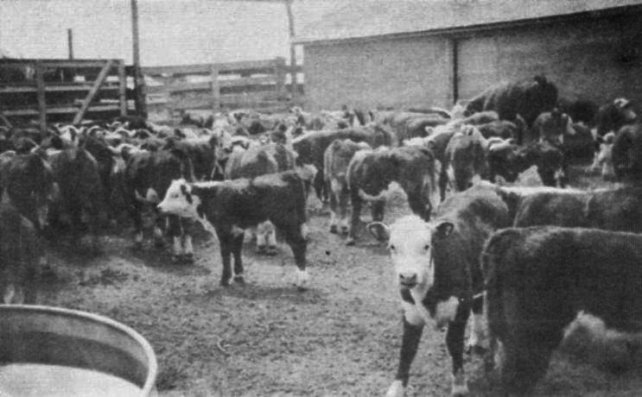
Home of Quality Feeder Calves
MABLE PARKER R.W. and DOROTHY BEELEY
COLDWATER, KANSAS
=========== Page 14 ==========
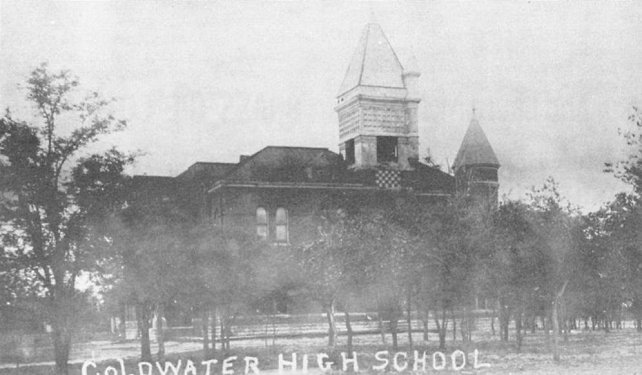
COLDWATER'S FIRST HIGH SCHOOL BUILDING BUILT IN 1889
THE COLDWATER SCHOOLS
The Coldwater school system first started in Coldwater in 1885. This was a subscription school and the teacher was Flo Chapman. In 1885 a school election was held and a County Superintendent was elected. In 1885 and 1886, a school house was built south of the Santa Fe tracks. This was a two room school building and is now occupied as a modern dwelling by Harrison Cook. It is the first house south of the tracks on the east side of the highway.
School was held here until 1889 when a two-story brick building was constructed on the present school location. The session of school held south of the tracks was troublesome. Students took things more or less in their own hands, so when the school board sought out a superintendent for the new school, an Irishman by the name of John P. Curran was employed. He taught school with an iron hand, was compelled to slap some of the unruly students and had to face angry parents, which he did by taking off his coat and showing readiness for action. This worked and peace was restored. His tenure in office ended in 1892.
The first graduating class from Coldwater high school was in 1892, which consisted of Edward Halliday, Ella McCune, still living, and Donna McCool. Jay T. Botts was the class of one graduating in 1894. He is still in the active practice of law in Coldwater at this time.
The first basketball game to be played in Coldwater was in 1914. The court was the theatre on the second story of the Neilsen --Peoples State Bank building. The goal posts were fastened to the bottom of barrels which were filled with stone to keep them upright.
=========== Page 16 ==========
In 1915-16 Coldwater High tied for the Englewood Branch League Championship consisting of eight teams and took a special train of 13 cars to Kingman, for the play-off with Norwich. Norwich won in an overtime game 41-40 when James McCay, lanky center, fouled out of the game. A special train took about 200 rooters to Protection that year.
Football was likewise introduced in 1914 and Coldwater has been a strong competitor in this sport from that day until the present.
Perhaps the most outstanding athlete in school history was Wayne Replogle, who was a powerhouse at fullback and who went on to be an all-state fullback at the College of Emporia and is now assistant coach at Kansas University.
So from then until now, when the alumni meet each fall for their annual homecoming and banquet, all firmly believe the words of their high school song---"We are the best....in all the west" and are sure this will continue down through the years. While here, Old-timers, pay the school a visit.
COLDWATER was first located 3.5 miles south of its present location.
=========== Page 18 ==========
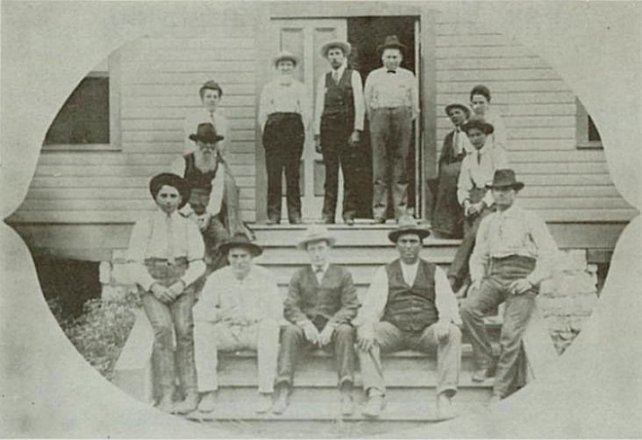
1904-05 County Officers: On upper steps from the left: R.A. Strain with beard: above him, Anna Huffmaster, County Supt,; H.I. Burr, Register of Deeds; J.M. Griffith, County Treasurer; Jay T. Botts, County Clerk; upper right, Nellie Botts, clerk in Treasurer's Office; to her left, Park Thornton and Vernie Griffith.
Bottom row: from the left: Lawrence Bratcher, Register of Deeds; Ralph Maris, Deputy Sheriff; Dr. F.L. Holcomb, Coroner; C.A. Fridley, Sheriff; and W.C. Monticue, Clerk of District Court. Comanche County, Kansas.
THE PEOPLES STATE BANK
The Peoples State Bank was organized and opened for business on December 5, 1905. The opening was delayed several weeks awaiting their safes arrival, making the bank unable to perform one of its most important functions of that time.
Its promoters and first officers were: J.R. Dominick, of the Traders Bank in Kansas City; F.L. Black of another bank in Kansas City; L.J. Solomon of Wichita and M.M. and Elmer Solomon of Kingfisher, Oklahoma.
Management changed in 1911 at the resignation of J.M. Cotton. A.C. Lambe served in that capacity until April 1919, when he sold his interests to Fred Jacks, who served as managing officer for 10 years, selling out to Garth McMillen of Leroy, Kansas, who served as president until his death, January 27, 1942. His son, Hobart McMillen, took over the management at the time of his death and continues to serve at the present time.
Since the year 1911, the following have served in the capacity of directors for various periods of time: A.H. Baker; J.W. York; J.M. McCay; J.M. Cotton; R.W. Scott; T.H. Crawford; A.C. Lambe; Fred Jacks; R.E. Parcel; Wilford Betzer; Garth McMillen; Mrs. Garth McMillen; Otha Landess; Ward H. Butcher; Martin Zerby; Walter Ferrin; Jack Helton; Harold Herd and Hobart McMillen.
=========== Page 20 ==========

Comanche County Hospital, Coldwater, Kansas.
COMANCHE COUNTY HOSPITAL
The Comanche County Hospital at Coldwater is a classic example of what can happen when people unite their hands, their heads and their pocketbooks.
In August, 1945, Ward H. Butcher, Coldwater editor, noticed an article about a proposed Public Health Law pending in Congress which would match $1 for each $2 paid locally, to assist rural communities in establishing hospitals. He wrote to Congress, hoping for a copy of the law and as President of the Coldwater Lions Club asked them to adopt a county hospital as a project, which they did.
The matter was presented and given hearty approval at Protection and Wilmore also, and a hospital committee from each community was selected. Later when their Lions Clubs were organized the hospital was their principal project. After a hearing in Topeka on hospital needs, the Comanche County Hospital priority was changed from 21st to 2nd place.
At an election on May 14, 1946, $100,000 in bonds for hospital construstion was approved 13 to 1 and later $50,000 more in bonds was sanctioned.
Bids for construction were let May 24, 1949. The government paid $74,000 of the cost--the first project of its kind in Kansas.
Construction started in June, 1949, on the 18-bed brick-veneer hospital, which was dedicated by Gov. Carlson August 12, 1950. The hospital was completely equipped by donations from the various communities, organizations and individuals of the county. It is now air-conditioned.
Few hospitals in the state have better equipment. Since its opening nearly nine years ago the hospital has cared for 4,634 patients and 543 babies have been born there.
The five-man hospital board appointed by the County Commissioners in 1946 has continued to serve with no changes. They are: Horace H. Rich, Coldwater, chairman; F.H. Moberly, Wilmore, vice chairman; Ward H. Butcher, Coldwater, secretary; Claude Rowland, Protection, treasurer; and C. Gardiner Lyon, Coldwater, member.
=========== Page 22 ==========

An Early Fourth of July Celebration in Coldwater.
THE FRADULENT BONDS
How would you like to have $72,000 handed to you? Five men did by a simple fairy tale plan. But to the people of Comanche County, who had to pay out the money with nothing in return, the plan was only too real. Yet $72,000 was just a drop in the bucket to what it actually cost them before it all ended.
The five men were A.J. Mowery and James Duncan, of Doniphan County; Alexander Mills, Topeka; C.C. Beemis of Reno County and J.S. Cox, buffalo hunter. They organized Comanche County in 1873 when there wasn't anything out here but cottonwoods, coyotes, jackrabbits and prairie dogs.
The men got up a petition containing names of "bona fide" inhabitants and sent it to Topeka, stating it was a list of settlers who wished to organize a county. The Govenor appointed Al Uudegraff census taker. He was to check the list of signers on the petition. He reported to Topeka that the signatures were correct. On October 28, 1873, the Govenor proclaimed Comanche County officially organized.
Election day was coming up so 240 names were copied from a St. Joseph hotel register and forwarded to the secretary of state as votes electing A.J. Mowery to a seat in the lower house of legislation. After being sworn in as the representative, Mowery got a law passed authorizing Comanche County to issue bonds and $29,000 was issued for a court house, $23,000 for bridges and $20,000 for general expenses. Some of the people, who years later had to pay, weren't even born when Mowery was boosting the law.
The bonds were registered in the state auditor's office and according to a Topeka paper of July 12, 1885, the bonds were issued by Alex Mills, chairman of the board of Comanche County to C.C. Beemis, George Veale and James Call.
They were sold to a speculator, Charles E. Lewis of London, England. The bonds were held about 11 years until Comanche County was once again organized and had taxable property with settled families.
Then Lewis sued the unsuspecting residents for $72,000.
The case was taken to court, and Comanche County lost. The first judgement was August 6, 1888. In the second case, an appeal by the county, the bondholder, Lewis, won again. That was on July 22, 1889. People of the county who had nothing to do with the bonds had to honor the debt and interest. Together bonds and interest totaled $126, 573.
=========== Page 24 ==========
Two months after the second ruling the county commisioners, Charles E. French; J.F. Cole; and John R. Morton, called a special meeting. They issued $126,573 in refunding bonds with 6 percent interest. These bonds were to settle the claim of Lewis. Also $6,500 was issued to pay G.G. Clemens, Topeka attorney, who handled the case for the county. By the time the original bonds and the refunding bonds were retired, March 18, 1941, Comanche County had paid $396,530.00 to settle the case and original issue, according to Walter Ferrin, County Clerk when the last bonds were retired.
Of the original five men who first organized the county, Mowery was the only one arrested. And that wasn't for the celebrated Comanche County bond case, but for a second bond matter in Doniphan County.
T.A. McNeal sums it up in his book, "When Kansas Was Young," when he remarked, "They will spend time and money to hang a man who "borrows" a $50.00 horse, but you can get by with stealing $72,000."
Join the Jubilee crowds and enjoy.
COMANCHE COUNTY POST OFFICES
The National Archives' "Records of Appointments of Postmasters, State of Kansas, 1849-1930" states that Daniel L. Cline was appointed Postmaster of Coldwater post office on October 17, 1884, on which date the office was officially established. However, Mr. Jay T. Botts of Coldwater, who came to this county in August, 1884, states that at the time of his arrival the post office was situated in a tent which was pitched on the present location of the Peoples State Bank building. For many years the office was located in the present day location of Gwen's Tot & Teen Shop, moving in 1917 to the south portion of the newly-erected Coldwater National Bank building, which was its home until August, 1958, at which time the quarters were moved to its present site in the Gilchrist building on Main Street.
The following is a list of those who succeeded Daniel L. Cline as Postmaster and dates of their appointments. Abraham Darroch, August 29, 1889; Lewis M. Rich, October 5, 1893; Samuel M. Jackson, September 21, 1897; Zelma P. Jackson, December 18, 1903; Lewis M. Rich, February 8, 1916; Henry A. Replogle, July 16, 1919; Orange J. Mark, February 1, 1924; Eyman Phebus, March 1, 1934; and Jack Vance, March 1, 1949, who is the present postmaster.
=========== Page 26 ==========
There were twenty nine post offices established in the vicinity of Comanche County during the 1870's and 1880's, most of which were located at large ranch headquarters, to serve the sparsely settled area.
At the present time there are three: Coldwater, Protection and Wilmore.
There are four Rural Routes and four Star Routes in the county today serving approximately 443 families. Coldwater has one Rural and two Star Routes. Protection has two Rural Routes and Wilmore has one Rural Route, one daily Star Route and one tri-weekly Star Route.
C. F. BIDDLE
Among the men who were identified with early Comanche County was C.F. Biddle. He was born in Williamsburg, PA., June 28, 1846, and attended Lancaster Academy in Pennsylvania. At the age of 17 he joined the Union Army and was with the Cavalry in the Battle of the Potomac. He entered the cattle business in Scott County, Kansas, in 1886 but the severe winter depleted his stock and put an end that venture.
He came to Comanche County in 1888 with 72 head of cattle and established the large Biddle Ranch. In 1898 he was elected to the legislature from Comanche County and served two terms. In 1884, he married Mrs. Frances Gregg, mother of the late Philo Gregg.
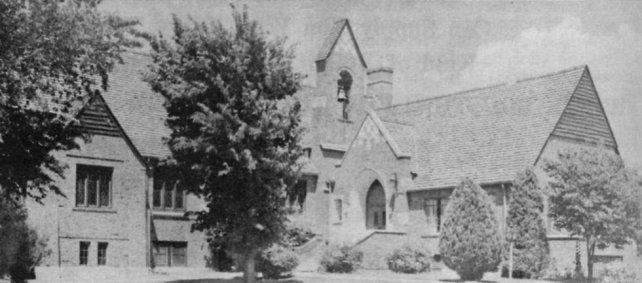
EARLY METHODIST HISTORY
by: Grace D. Cloud
In 1885, a band of citizens organized a class to plan and build a Methodist Church in Coldwater. Rev. William Hays was appointed pastor by the annual conference at Winfield, Kansas.
The charter members were: J.W. Harding; Mrs. Hannah Harding; J.A. and Mrs. Pennington; Nellie Hays; M. P. Hays; Lizzie Humphries; M.E. Hale; Mr. Kee; Zelphia Murray; Allan Ross; B.F. Smith; J. Thompkins; H.B. and Julia Thompkins and Jennie Thompkins.
Four days after Rev. Hays appointment he arrived in Coldwater and preached his first sermon in Vickers Hall at the corner of Main and Central and also preached at Avilla.
In 1886 a Methodist Church was erected at the corner of Maple and Philadelphia. It was furnished and occupied within three weeks with a Sunday School and Missionary and Ladies Aid Societies.
Rev. J. A. Davis was pastor, followed by Rev. F.C. Faye, who also served Protection for 21 months. "A Band of Hope" Epworth League was organized.
Eighteen years later a larger church was built on the present site at Philadelphia and Cottonwood streets. In 1903 during the pastorate of Jessie Clyde Fisher, it was partially destroyed by a fire. The church was enlarged and served the community until the present English type church was built on the same location during the pastorate of Rev. C.C. Brown in 1930.
The church has grown from 16 members to a membership of 470 in 1959.
THIS PAGE SPONSORED BY THE FOLLOWING:
DR. H. S. SCHULZ HERMAN SCHULZ EDITH SUNDERLAND-SCHULZ
JAY T. BOTTS CLYDE A. BLOUNT
=========== Page 28 ==========
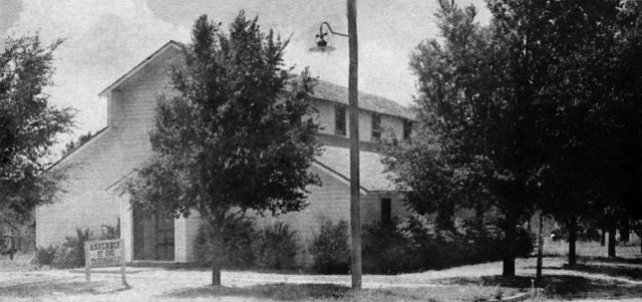
HISTORY OF ASSEMBLY OF GOD
The Coldwater Assembly of God was begun as a result of a group of spiritually hungry people from Wilmore and Coldwater. This group under the leadership of C.W. Swafford met in homes for prayer meetings. They decided to call Evangelist Nellie Cox to conduct a tent revival at Wilmore. The meeting was held in an alfalfa field just north of the city. During the meeting a number of people expressed their desire to have a tent revival conducted in Coldwater.
A tent was set up on Main Street in August, 1926. Much interest and discussion pro and con came as a result of this tent meeting. Shortly thereafter the converts of this meeting held services in a hall above a store on Main Street and during this time these converts began construction of their church. A parsonage was built one year later.
On October 18, 1926, the Assembly of God was set in order with thirty-three charter members. From these humble beginnings 18 have entered the ministery. Some have gone as missionaries, pastors and professors in a seminary.
The church has just completed a $5,000.00 addition to the parsonage under the leadership of Pastor Markstrom. This addition includes adding about 400 square feet to the first floor and 800 square feet to the basement. The basement has a kitchen and complete bath plus a large room for church activities.
WILLIAM HENRY KNECHT
William Henry Knecht, who was born in Michigan, and came to Comanche County in 1884, went through all the hard times of early days and was always identified with any movement that would in any way benefit Comanche County. For 10 years was postmaster of Avilla, which was located just south of his farm.
=========== Page 30 ==========
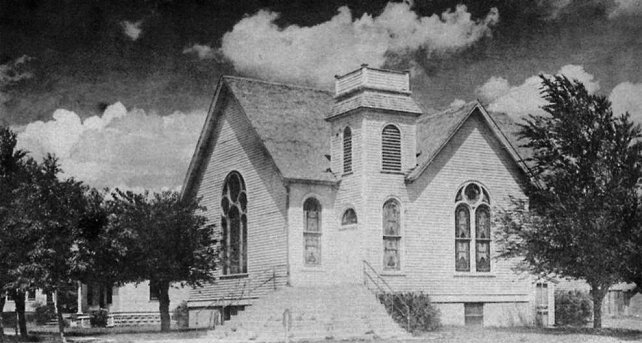
CHRISTIAN CHURCH HISTORY
In April, 1909, E.A. Newby of Wichita held a series of meetings in Coldwater, the outcome of which is the Christian Church. The Church School was organized April 18, 1909. Until the Harbaugh Opera House was finished the congregation met in the court house beginning June 20.
Anxious for a permanent home, the new congregation was soon making plans for a building and at a joint meeting November 17, 1909, the church's board and the Ladies Aid Society laid plans for a $4,000 unit. In April, 1910, the carpenters commenced work and as the building progressed amazingly fast, the dedication date was set for July 17. The parsonage was erected in 1914 and later the east room was added. In the early 1950's further improvements were made.
In April 1959, the congregation celebrated its Golden Anniversary. Twenty-two ministers have served the church in its 50 years of service to the community. In the planning stage, at present, is an educational building program to accomodate the growing congregation.
Enter To Worship ------ Depart To Serve
DAVIS T. McINTIRE
Davis T. McIntire, one of the earliest settlers of Comanche County, was born in Mercer County, Kentucky, January 11, 1847, and spent his boyhood days on his father's farm in Kentucky.
He came west and was in Dodge City when the first house was built there. At this period of life buffalo still roamed the plains in large numbers and hostile Indians were not unusual. He came in contact with them several times. For two years he hunted the buffalo for their hides, making this activity his regular business during that period.
He came to Comanche County in 1877, locating on Mule Creek, where he entered the cattle business and participated in all activities of the cattlemen during the first and second periods of the industry. Mr. McIntire was a member of the first board of County Commissioners, after the organization of the county in 1885. In 1887 he was elected sheriff, serving four years. He was later elected sheriff for two more terms and in 1902 was elected to the state legislature.
On October 6, 1876, Mr. McIntire was married to Miss Acenith C. Bailey, who was born in Indiana in 1861. A very young bride to cope with the wilderness but born with the foundation of a true pioneer, one whose name will go down in history of Comanche County as being the first white woman in the country and who went through the Indian uprising of 1878 and assisted in caring for the wounded victims of the Redman.
HOWARD R. BURNETT
Howard R. Burnett, born October 23, 1858, came to Comanche County in 1887, settling on government land east of Coldwater and was a cattle raiser. He held various township offices and was County Commissioner at the time of his death.
A movement is afoot to build wooden sidewalks on Main Street.
=========== Page 32 ==========
COLDWATER DIAMOND JUBILEE, INC. presents
PAGEANT OF THE PRAIRIE
A John B. Rogers Production. Produced and Directed by Leo Spaeth.
HIGH SCHOOL STADIUM, COLDWATER, KANSAS,
AUGUST 31, SEPTEMBER 1 AND 2, 1959,
8:15 P.M.
===== SNYOPSIS OF EPISODES AND SCENES =====
Prologue
A fanfare proclaims the arrival of the Mounted Guard, followed by The Color Guards of Honor....In a tribute to our Youth, we present the Boy Scouts and the Girl Scouts...The Sailorettes and Cadets enter to form The Lane of Flags, through which come, in regal procession, "Miss Columbia" and the Original States, "Miss Alaska" and "Miss Hawaii", The Nations' Queens and the Jubilee Princesses....The Trumpeters now play a Royal Fanfare and Her Majesty, "Miss Comanche County", enters with her attendants to receive the acclaim of Her Loyal Subjects....
EPISODE ONE:
"The Comanche County Story"
We salute the representatives of our Pioneer Settlers, whose struggles, romances, defeats and grand accomplishments we here re-enact.....
EPISODE TWO:
"Comanche Village on the Creek"
It is long before the coming of the Pioneers...We visit a typical Comanche village....The Medice
ine Man performs a wierd ritual...Fur Traders arrive and the Indians are at first startled at their first vision of "Strange, White Gods"...the Chief performs the Ceremonial of The Calumet and then bids his warriors to execute the Tribal Dance for the friendly Traders...
EPISODE THREE:
"Unto This Land"
We watch arrival of a Wagon Train in the 1880's...Then we join the settlers as their simple story is told...A tale of grim foreboding, with a seasoning of frontier humor to make life worth the living....The peace of the night is broken as the Indians attack...Thwarting the enemy, the train moves slowly on toward the stream.....
EPISODE FOUR:
"An Early Wedding"
Folks come from miles around in the county to attend one of the first marriages...And the Justice, interrupted by one of Al Jennings pranks, finally "ties the knot"....The event is celebrated in grand style with a concluding and spirited Square Dance.
EPISODE FIVE:
"The Seventh Day"
We recreate an old fashioned Religious Service in the days of long ago....The congregation arrives to greet their minister....As the chimes softly intone a hymn, he reads the Psalm, then, as he calls them to prayer, suddenly the spoken words become a mighty anthem and as the music swells, the side stages reveal two tableaux, symbolic of Religion Through The Years......
EPISODE SIX:
"Readin`, `Ritin and `Rithmetic"
We are priviledged to take a peek into the classroom of Mrs. Flo Chapman, our first schoolmarm and to re-live a session wherein she painfully endeavors to impart the principles of the "Three R's" to urchins destined to become our great-great-grandparents....
EPISODE SEVEN:
"A County is Born"
It is April 2, 1885, and Frank Holmes introduces the newly elected County Commissioners and other officers of Comanche County, almost overlooking himself and then suddenly remembering that the stork is overdue at his home.
EPISODE EIGHT:
"The Coming of the Iron Horse"
Now it is late afternoon on September 15, 1887, and there is great excitement in Coldwater as the folks come into town to watch the first Atchinson, Topeka and Sante Fe train steam into the depot....A lady almost misses the cinder-spewing goliath, but all ends well as the assembly takes places on the sward for the dancing of the dainty "Virginia Reel"....
EPISODE NINE:
"The Dalton Boys Stage A Robbery"
The "Boys" are gathered on the porch of Steve Knecht's store on an evening in the late autumn of long ago.....As they contemplate what a threatening frost might do to the "mushmelons" left outside overnight, the
Dalton Boys slip up, rob the men, then the store and the postoffice and then send the gentry running east as they depart with the smallest "take" they ever "corralled" ......But here comes retribution as a shooting posse starts a chase.....
EPISODE TEN:
"Gay Nineties Picnic"
It is the Fourth of July, 1900, and we are guests at a country picnic....Here come the "Bathing Beauties of the New Century", escorted by the members of the baseball team (how did THEY get into this?) .....Now the daring "Can-Can Girls" shock the women with their dance from "Gay Paree".....Miss Fifi La Toor now offers her version of "Grand Opry", but an ascending sky-rocket takes away her entire audience, after which she tacks the blame on a lone remaining policeman.
EPISODE ELEVEN:
"World War One"
We pay solemn tribute to the "Buddies" who never returned after the First Global Conflict, as two Gold Star Mothers place wreaths on a row of crosses, "Taps" are sounded and the stirring verses of "Flanders Field" are intoned.....
EPISODE TWELVE:
"The Roaring Twenties"
Here, in 1920, we enter the swinging "Jazz Era" as we watch two "dandies" from Protection "date" a "flapper" from Coldwater.....A purely fanciful scene of the times, culminating in a "Charleston Contest" at the old dance hall.....
EPISODE THIRTEEN:
"World War Two"
We honor the heroes of the Second World War and view a moving depiction of "Flags Raising on Iwo Jima".....
EPISODE FOURTEEN:
"The Beginning, or the End?"
It is the Present and we are living in the Age of the Cold War....We pay tribute to our Korean War Veterans.....Then, to bring us closer to its mighty import, we see the explosion of a simulated Atomic Bomb, the rise of it's firey particles and its final mushroom of billowing smoke...
THE FINAL EPISODE:
"To The Future"
We bring back the entire cast to pay homage to our Queen, "Miss Comanche County", and we toast Coldwater on its entry into the last twenty-five years of a Century of Progress.....Then, after we sing the National Anthem, the lights blackout and we view a gigantic display of fireworks.....
=========== Page 34 ==========
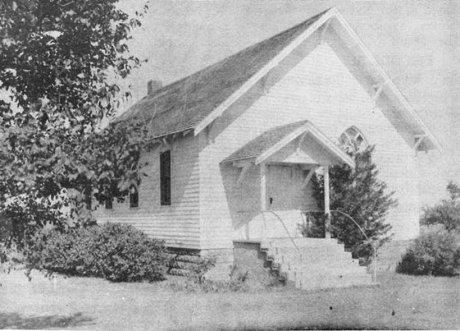
HISTORY OF FRIENDS CHURCH
The first religious service held in the Prairie Vale community about six miles northwest of Coldwater was a Bible School organized in 1891. The B.E. Newlin, John T. Maris, Ira Hadley and James Hadley families with some other early-day settlers met in the home of B.E. Newlin, a frame building 12 by 16 feet.
In 1892 the school district purchased a house in Greensburg and moved it by wagon to a site one-half mile east of where the Prairie Vale Friends Church now stands. This served the purpose of a school house and also a meeting place for the Bible School.
In December 1897, the monthly meeting was established by the Haviland Quarterly Meeting. In 1898 the meeting purchased a frame building in the southeast part of the county and moved it in sections to the present location. In July 1898, the Bible School reported a membership of 46, 28 of whom were Friends.
The present parsonage was erected in 1915, when we had our first pastor. Fourteen different pastors have served the church since 1915. The present church building was dedicated April 24, 1927.
The membership record reveals that, through the years, including the present membership, 417 people have belonged to the Prairie Vale Monthly Meeting of Friends. The church is located five miles north and one mile west of Coldwater. If you want to be among "Friends" come where "Friends" meet.
The first death recorded in Coldwater was that of George, the six-year-old son of Mr. and Mrs. S. Barker, on October 18, 1884.
=========== Page 36 ==========
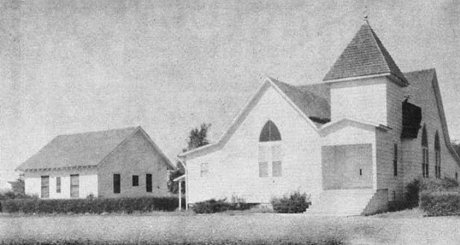
ANTIOCH CHURCH HISTORY
The early settlers in Comanche County first established homes, then erected school houses and worshipped in them until they could build churches. In those days the community was only as large as the school district, so there were Sunday Schools in almost every school house. South of Coldwater, the Avilla, Salt Fork, Fairview, West Creek and Missouri Valley school houses were used.
By 1915-1916 cars were fast replacing the horse and buggy. It was at this time that William Oller of Salt Fork and Henry Knecht of Avilla, suggested a new, centrally located church.
A building site, 11 miles south of Coldwater, given by Moritz Baessler, was accepted and on May 6, 1917, the Antioch Methodist Church was dedicated. There were 38 members. Cars made necessary good roads and both eliminated distance, so on January 18, 1948, the Fairview Church disbanded and became members of Antioch.
In 1949 the unused Salt Fork school house was moved to the church yard and made into a modern parsonage. When Rev. Bill Dial and family moved in, Antioch for the first time had a full time pastor. The church's membership is now 166. Rev. Howes is now serving his fifth year as pastor.
Antioch is the only church building in Comanche County south and east of Coldwater to the Oklahoma state line.
JOHN W. STARK
John W. Stark was born at Tiffin, Ohio, November 22, 1858. He received his education in the schools of Minnesota and Missouri. In 1884 he came to Kansas and located on government land in Avilla township, where he conquered the land and was a successful farmer and rancher.
=========== Page 38 ==========
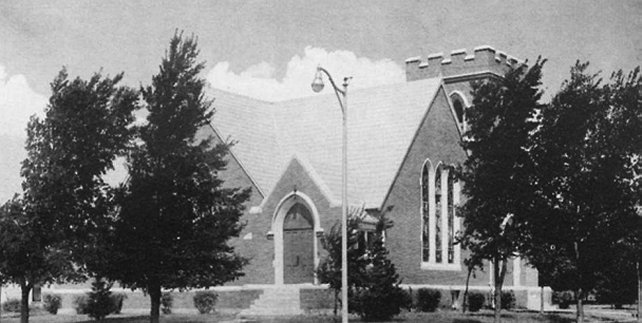
PRESBYTERIAN CHURCH HISTORY
The First Presbyterian Church was organized January 23, 1887, with 14 charter members, six men and eight women. None of these are living now. Services were held in the school building for 11 years. In 1898 the unused United Presbyterian church building was bought and moved to the present site. Within the year this building was completely destroyed by a tornado. A building was then moved from Greensburg and served until 1913, when the present church was built and dedicated.
Ten part-time pastors served the first 13 years. Rev. W.L. Roberts, the first resident minister, served from 1901 to 1908, when he retired from the ministry. In 1917 while Rev. A.G. Alexander was pastor, the pipe organ was installed and has been a joy to the community through the years. The church has had twenty-six pastors in the seventy-two years and each one has left his work for some special work he has accomplished in the church and community. Ministers' salaries have grown from an early day rate of $75 for six months' service to the present budget of $9,000 with a salary of $4,500.
A noteworthy project now of interest to the church and the community is Camp Lark, a Presbyterian Youth Camp near Coldwater. The first unit is under construction at this time. Rev. Carl Grondorf is the present pastor of the church.
FIRST CHILD BORN HERE
The first child to be born in Coldwater was C.M. Cade, Jr., as is recorded in a deed at the court house which for $1.00. C.M. Cade transferred a piece of real estate to his new son.
===========page 40=============
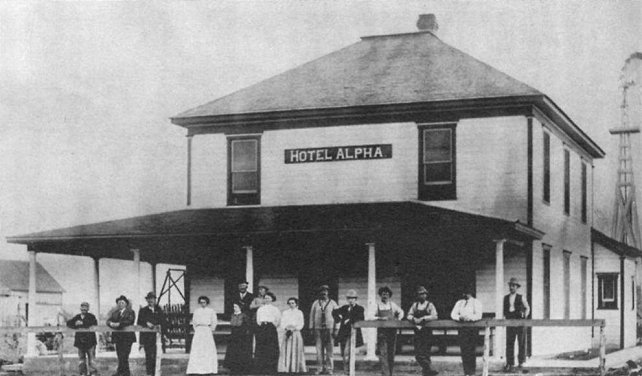
The ALPHA HOTEL AT WILMORE, one of the county's prominent hostelries, was well patronized by the ranchers and townspeople and was also a social center. Shown are the Albert Heflins, hotel managers; Bruce Snare, Francis Larimer, Mr. McGraflin, lumberman; Mrs. Thos. Wilmore and son Ray; Tom De Jarnett and Sallie Davis.
A 1908 photo.
WILMORE HISTORY
The town of Wilmore, Comanche County, Kansas, was named after Thomas Wilmore in the year 1876. He lived there 30 years. A considerable part of this time he was postmaster of his home town. He was also engaged in livestock and ranching business and had a prominent part in the development of that new country. He was married to Mattie A. Wright, July 2, 1888, at Wilmore. She was also a resident of the county and several of her descendants now live in Comanche County.
Wilmore began to grow in 1915 and was very prosperous. At that time there were several places of business, among them a variety store, blacksmith shop, grocery stores, etc. Later, stores were owned by Perry Williams, John Bell, and the Rosses. The Alpha Hotel was run by Mr. and Mrs. Albert Heflin. At a still later date stores were owned by D. Fisher, Charlie Ray, and C.E. Richardson.
Several of the original houses of the town have been remodeled and are still providing homes for our citizens in 1959. The first church of the town, the Baptist, was organized by a farmer, I.W. Bailey. This church celebrated its 50th Anniversary in 1958. A Methodist Church and a Christian Church were organized soon after the Baptist Church started.
The first grade school was in the north end of town. The first high school class was graduated in 1918. Early-day citizens who are still remembered are John Bell, Barry Ware, O.P. Snare and many others.
=========== Page 41 ==========
IN MEMORY of GODFREY J. ISENBART
December 13, 1881 - April 10, 1959
He moved with his parents in 1897 to a homestead north of Alva, Oklahoma. He was united in marriage with Dora Alice Bean on April 24, 1912, amd from that time resided
on the farm situated 11 miles east of Coldwater, which had been homesteaded by Mrs. Isenbart's father, C.M. Bean, in the spring of 1885. Mrs. Isenbart has been a Comanche County resident for nearly 70 years.
Sponsored by Margaret Isenbart-Morris
IN MEMORY of CHARLES E. BAKER, SR.
County Attorney of Comanche County, Kansas, 1912 - 1932.
Twenty years of service by one of
Comanche County's finest citizens.
Sponsored by: Mrs. C.E. Baker,
Winfield, Kansas.
=========== Page 42 ==========
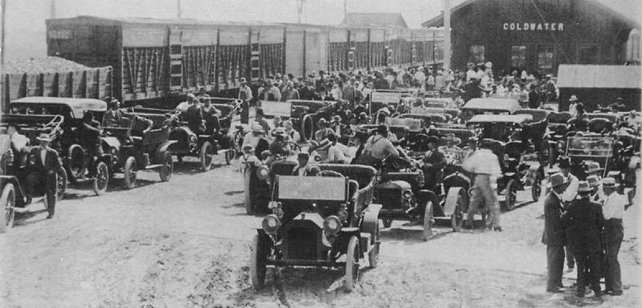
THE TRAIN BRINGS NEEDED HARVEST HANDS TO SAVE THE WHEAT CROP
MEMORIAL ROSE GARDEN
The Friendship Memorial Rose Garden in Coldwater was planted in the city park in the spring of 1940, to honor the memory of our men and women who gave their lives, in the service of our country and others who were in the service.
The design of the garden is significant. The semi-circular rose beds contain colored roses dedicated to men and women who spent time in the service. The memorial section is a complete circle with flagstaff in the center and is symbolic of a completed life. The roses dedicated in this bed are in memory of the dead who gave all toward Freedom and Peace in the world. White roses are planted here, indicative of purity of purpose.
Following are the names of the Honor Roll dead for whom this bed is dedicated:
John R. Crawford * Harrison Metzger * Guy A. Schrock * Eugene M. Wares.
World War II
Donald F. Betzer *
Robert Booth Jr. *
H.R. Burnett *
Marian L. Canfield *
Johnnie L. Casteel *
William H. Finney *
Wm. M. Griffith *
Lee H. Hecht *
Aubrey C. Holland *
Robert L. Hough *
John D. Jenkins *
Ivan Keesee *
Howard R. King *
Martin B. McMillen *
Hugh H. Melrose *
Leighton Metzger *
Clarence L. Oller *
Melvin B. Park *
Warren L. Petty *
Alfred G. Seidel *
Herbert L. Seyfrit *
Eric A. Sims *
Elvin E. Smith *
Ralph Sooter *
Hobert H. Thompson *
Leo Curtis Thrall *
Ernest A. Trummel *
Donald G. White *
Donald E. Wright *
Squire B. Zane
Korean War
Lloyd L. Alder Jr. *
Wayne F. Burkhall *
Robert Roy Burnett *
Donald Keith Huck *
Leslie E. Jellison *
Merle D. Pearson *
Leonard D. Smutz *
Wayne L. Thompson *
The Rose Garden was first sponsored by the Research Club with a rose garden committee as the active agency, then in 1948 the Research Club ceased to sponsor it and the City Council, with the rose garden committee co-operating, continued and made it a community project.
=========== Page 44 ==========
Through the years many have given contributions, paid for replacement of roses, have donated time and equipment, have given to the permanent improvement of the garden and are interested in keeping it a place of beauty and inspiration. Hundreds of baskets of roses have been taken to bereaved service families and to sick veterans at home and in the hospitals. Each Memorial Day a basket of roses from the garden is placed at the base of the shaft in the cemetery on which our honor roll is engraved.
On October 21, 1945, roses were sent from the garden to the Tweltfth Naval District and there aboard the U.S.S. Brownsville, 10 miles outside the Golden Gate, the roses were committed to the "Deep" in honor of our boys who died in the service of the United States Navy.
The garden is a reminder of the price that free people had to pay for Peace and Freedom. May we never fail in our devotion to these values that this price will not have to be paid again.
In recent years Robert Keesee has taken care of the garden, working with Mrs. Jay B. Pounds, who is the present chairman.
THE FARM BUREAU
The Comanche County Farm Bureau was organized May 1, 1918. Roy German was appointed to serve as president until they could hold their first election. In the fall of 1919, Mark G. Brown was elected as their first president. Since the first election they have had 19 different presidents, some serving for just one year and some serving as many as four years.
The first County Agent was E.L. Garrett. Since then they have had nine County Agents and H.L. Murphey served nearly 12 of those years. The first Home Demonstration Agent was Ethyl Danielson. Six Home Demonstration Agents have served here. In 1952 came the separation of the Farm Bureau and what is now known as the Extension Council. Since this separation the Extension Council has had six presidents and a few have served two years.
The Farm Bureau Association moved their office to its present location. Robert Sanders, the Farm Bureau Insurance Agent, has his office also in the same building with the Farm Bureau Office. The Extension Council office is in the basement of the court house.
=========== Page 46 ==========
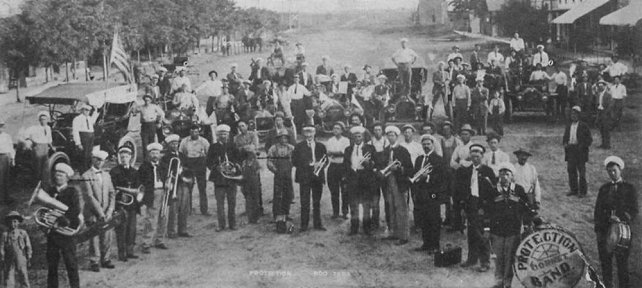
A 1910 PICTURE OF PROTECTION BOOSTERS AND BAND LOOKING NORTH ON MAIN
STREET IN THAT CITY
BRIEF HISTORY OF PROTECTION
There are two stories about the naming of Protection: One is a traditional story having to do with an Indian scare when the people collected at Red Bluff for protection. It was, according to tradition, an attempt on the part of the cowboys to frighten the early settlers. The other story is a matter of history, the name Protection being given from a protective tariff of that decade, 1880-1890.
The town became nationally and internationally known via radio and television in 1955-1956, when the National Polio Foundation chose it as the center for the free distribution of Salk vaccine shots for polio. It then became 100 percent protected. Protection is the only town of that name in the U.S. with a post office.
=========== Page 48 ==========
HISTORY OF COMANCHE POOL
In 1880 the largest cattle ranch ever to be established in Kansas was organized and named the Comanche Pool. Previously, millions of head of cattle were driven from Texas to markets in Kansas until the Indian Authorities at a new post in Oklahoma, known as Sheridan's Roost, forbid the cattle to pass through on the old trails. Within two months after the closing of these trails Jess Evans, R.W. Phillips, Wylie Payne, Major Andrew Drumm organized the Comanche Pool.
The idea was to gather all the local cattle into one great herd and divide the expenses and profits in direct ratio of each owner to the whole herd. When the expenses were totaled it averaged out $1.00 per year or 9 cents a month to keep each head of stock. They started business with 26,000 head and about 11,000 annually. The peak was reached some 5 years later when 84,000 were in the Pool.
This great amazing area covered about 4,000 square miles and needed a regular army of cowhands to patrol it. The borders were roughly from Waynoka, Oklahoma, on the south, the west and north sides of Comanche County and east within a few miles of Medicine Lodge. Headquarters for this great spread was at Evansville in the eastern part of Comanche County, where a warehouse was built to store the wholesale food and clothing sent out from Kansas City.
According to Mrs. Frank King, whose husband was the last range boss for the Pool, line camp riders lived in dugouts or sod houses built about a day's ride apart. In addition, three principal horse camps were maintained and at roundup time each cowboy had at least seven good horses available, one for each day of the week.
In the fall of 1885 the Pool's count of cattle numbered close to 84,000 head, then came the terrible blizzard. When spring opened in 1886 the count was 13,000. The small ranchers were completely wiped out and the remaining owners moved their stock to Montana or the Indian Territory. Settlers took over most of the grazing land and broke up the sod for grains and so started the pattern of our county of today.
=========== Page 49 ==========
IN MEMORY OF
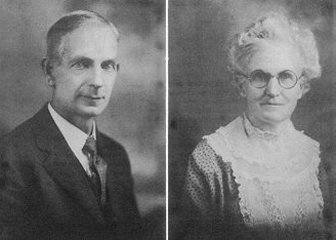
Mr. and Mrs. W. V. Jackson
W. V. Jackson was born in Dayton, Ohio, in 1863 and came to Comanche County in
1885 and settled on a claim in Shimer Township. Mrs. Jackson, nee Rose Robertson,
was born at Spirit Lake, Iowa, in 1868. She came to Comanche County in 1884 with
her mother, sister and brother and also settled on a claim in Shimer Township.
They were united in marriage in 1889 and to this union were born four children: Dan N.
Ruth (Mrs. Fred Beitler), Charles R., and Lucille (Mrs. Wilford Betzer).
Mr. Jackson served two terms as Comanche County Treasurer and also served six
terms in the Kansas House of Representatives. As pioneer settlers they had many
trying experiences, but with unswerving faith and patience they built their home and
resided at "Valley Farm" until their passing.
=========== Page 50 ==========
COLDWATER DISTRICT LIBRARY
The Research Club established in 1912 what is now lnown as the Coldwater District Library. Starting by gifts of about 200 books, by united effort, the library was enlarged and maintained by the club until 1918 when with community help it became the Coldwater City Library.
In June 1945, the Coldwater Library was established at Wilmore for readers of the east side of the county. Thousands of books have been circulated between the parent and branch libraries since then.
The Library for the first 21 years was housed in the old Community building and on Main street. In 1933 it was moved to the basement of the courthouse where it remained until 1958, when Mr. and Mrs. Jay B. Pounds gave it a permanent home at 107 North Central.
The first librarians were club women who donated their time. The following have been salaried librarians: Pearl Gerhart, Sophia Holmes, Anna Cooper, Georgina McNeill, Helen Stephens-Rush, Ethel Smith, Marie Campbell-Tinker, Dorothy Avery and Vivian Replogle. Wilmore Branch: Helen Wood and Alzina Baker.
Through the years many men and women have generously given their time and ability to improve and make the Library one of its finest for its size in the state. It is an outstanding cultural and educational center within the county.
The Library now has 10, 667 volumes, receives forty periodicals, 1 daily newspaper, 1 weekly newspaper and the New York Times Sunday edition. In 1958, 887 readers checked out 15, 417 books and much browsing and reading is done in the reading room of the library.
The Library has on exhibit several oil paintings, which are gifts of local amateur artists, also several which have been loaned to the library.
=========== Page 51 ==========
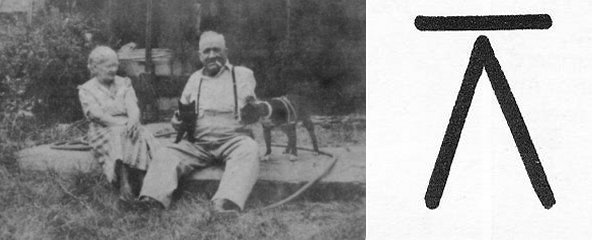
GREGG RANCH
Mr. and Mrs. Philo Gregg
At right: The Gregg Ranch Brand
The Gregg Ranch, formerly known as the Biddle Ranch, was acquired by the late Mr. and Mrs. C.F. Biddle, who came to Comanche County in 1888.
His step-son, Philo Gregg, came to Comanche County in 1904 and he and Mrs. Gregg continued to make their home on the Biddle Ranch until his death February 10, 1946. The ranch is now owned and operated by Mrs. Lula Gregg, Muriel and Charles Gregg and Donald Booth.
=========== Page 52 ==========
EARLY-DAY RANCHES
One of the best-informed persons about early Comanche County ranches is Clarence Coles. He submitted the following list as the earliest ranches he could recall:
Mortimer R. Platt
Smith and Mussett
Jake Kehl
George Briggs
John Lightner
W.V. Jackson
C.F. Biddle
Scott Brothers
T.J. Curran
Ambrose De Lair
Bob Estill
Gallagher
Shaw
Cap Pepperd
Freemont Rogers
Moffett,
Lewis and Andrews
Frank Garst
C.M. Cole
Howard Burnette, Sr.
Phillip Lenertz
Sombart Ranch
D.T. McIntire
Jake Kurz
Frank King
JOSEPH TAYLOR
Joseph Taylor was born in McLean County, Illinois, March 23, 1873. He came to Kansas with his parents in 1875, settling in Cowley County, thence to Comanche County in 1884, where he received his education in the public schools. At an early age he tried stock raising and with success, then about 1908 he was elected District Clerk of Comanche County on the Democratic ticket and was re-elected to that office for many succeeding years.
=========== Page 53 ==========
PIONEERS CITIZEN'S FAMILY
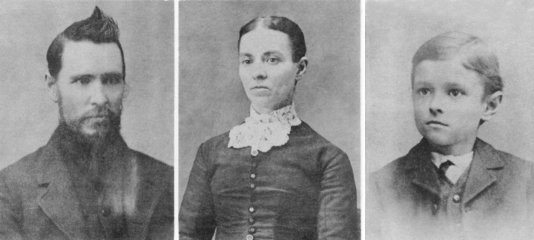
MR. AND MRS. E. T. DODSON and FRANK DODSON
E. T. Dodson, his wife and two children, Frank and Grace, arrived in Coldwater, Kansas, during the winter and spring of 1885, Mr. Dodson in February, and the family in May.
He pre-empted a quarter-section of land near Avilla and built a home, where they lived until the town faded away. They then moved the house to land he had bought five miles south and two miles east of Coldwater, but lived in Coldwater and operated the farm and ranch from there.
SPONSORED BY FRANK DODSON AND MR. AND MRS. HARRY B. CLOUD
=========== Page 54 ==========
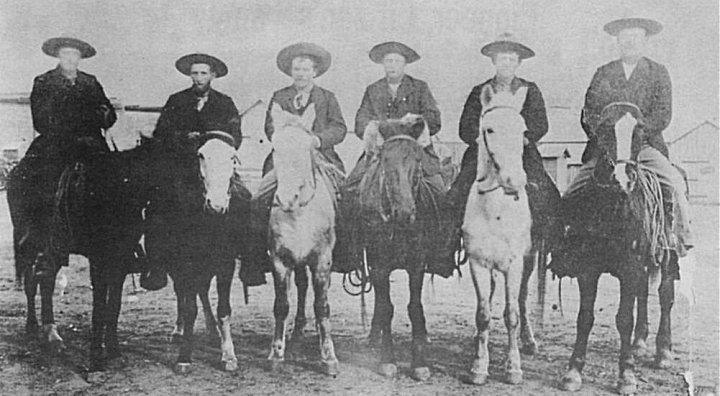
COWBOYS EMPLOYED BY THE COMANCHE POOL:
This rare picture shows a few of the many cowboys employed by the Comanche Pool to ride the hundreds of miles of barbed wire fence which enclosed some 40,000 acres of government grass in Barber and Comanche Counties.
Left to right: Unidentified, Barney Armstrong (thought to be), Mike Cavanaugh,
Frank King (the Pool's last range boss), Bud Snow, Joe Bowers (later a Coldwater saloon keeper - the only man killed.
The wooden building shown in the rear at the right was Barber County's first jail.
=========== Page 55 ==========

IN MEMORY of EDWARD and ELLA DEEWALL
Mr. and Mrs. Edward Deewall and two sons moved from Hancock County, Illinois to their home seven and three-quarters miles south of Coldwater in February, 1892, where they lived until their death.
Their children are Paul, Roy, Ollie Hackney, Ruth Shephard, George Deewall and Laura Lohrding, all of this county except Ruth, of Wichita. The descendants of this pioneer family now number 80.
The biggest tragedy of this family was when the tornado of May 1, 1938, hit and nearly demolished the buildings on the farm, although the house was rebuilt on the same foundation.
SPONSORED BY THE DEEWALL FAMILY
=========== Page 56 ==========
MRS. FRANK KING
Mrs. Frank King came at the age of 16 with her parents, the George Parkers, from Shelby County, Missouri in 1886, the family of 11 settling on Poverty Flats in Comanche County, where there was only bare prairie , deer and antelopes. One time, she recalls, the cowboys killed a bear while herding cattle and gave it to the Parkers. Mrs. Parker rendered five gallons of grease from the animal.
Mrs. King was married to Frank King, foreman of the Comanche Pool, at Medicine Lodge in April, 1889 and they set up housekeeping in one of the Pool's houses on Red Fork, the year the Pool disbanded, then moved to their own ranch, where they lived 35 years before coming to Coldwater in 1911. Mr. King died in 1915.
Though 98, Mrs. King still has a keen mind and is an authority on Comanche County history.
JAMES SAMUEL HUDSON
James Samuel Hudson, born in Adrian County, Missouri, came to Comanche County, 1885. Located on government land, Avilla township. Among very first settlers in that locality. Lived in a sod house.
=========== Page 57 ==========
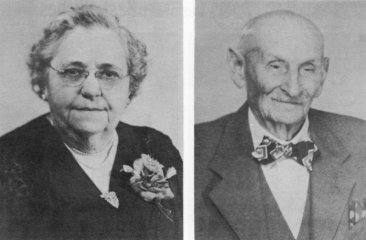
MR. AND MRS. JACOB KURZ
Born November 2, 1862, Mr. Kurz moved from Green Bay, Wisconsin, to stake a claim in Comanche County in 1885. His wife, Rosa, was born March 20, 1874, and came from Warsaw, Illinois, at the age of 13, and lived on a claim with her mother. The couple were married on November 2, 1892 in a sod house on Salt Fork Creek and later built the first frame house in Comanche County.
Before his marriage, Mr. Kurz worked as a railroad construction worker, helping build a new Santa Fe line from Kiowa, Kansas, through the Indian territory of Oklahoma and also worked on railroads in Montana and Idaho. He tried general farming for awhile but decided it didn't pay so turned to raising cattle.
When the Cherokee Strip opened in 1893, the Kurz' neighbors left for "greener pastures", but Mr. Kurz, who had a few head of cattle, decided he could not better himself by pulling stakes. Gradually he bought more land and cattle.
On retirement, Mr. Kurz turned active management of his ranch and farms over to his sons-in-law Fred Parker, Ernest Oller and John Swaim. He also owned extensive holdings in the city of Coldwater.
Mr. Kurz passed away in 1951 at the age of 88. Mrs. Kurz will have been a patient in the Comanche County Hospital four years this November. She is 85 years of age.
The Kurz family consists of three daughters, five grandchildren and four great grandchildren.
THIS PAGE SPONSORED BY THE THREE CHILDREN
ROSE OLLER, ETHEL MAE SWAIM, MABLE PARKER.
(Webmaster's note: The Dodge City Globe, in 1877, commented on the frame house built by Cap Pepperd on his Comanche County ranch.)
=========== Page 58 ==========
DAVID F. EDMONDS
David F. Edmonds was born in Albia, Monroe County, Iowa, June 24, 1842.
When eleven years of age he came to live near Leavenworth, Kansas. As a young man he worked on farms at various places in Kansas, and at that time Kansas had only a few settlers and no large towns. Wichita or Hutchinson had not yet been organized. During the years of 1856-57-58 he was an assistant freighter for the government.
After serving in the Civil War, Mr. Edmonds was in 1865 united in marriage with Miss Lois Dunlap, who died in 1916. In the fall of 1874, Mr. Edmonds came to Comanche County and located on Mule Creek, being one of the very first settlers in this county. The land on which he located is now known as the Rice Price ranch.
Mr. Edmonds died in Coldwater, May 21, 1930, and with his death passed the last Civil War veteran in this county.
NEW TOWN OF GREENSBURG
A new town north of Coldwater was started a few months after Coldwater became a city and soon drew over the town of Janesville and were contenders for the county seat.
=========== Page 59 ==========
IN MEMORY OF
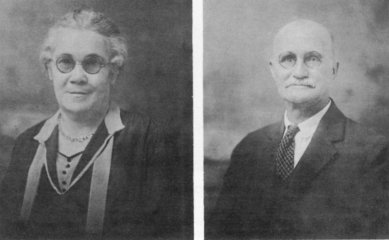
MR. AND MRS. WM. OLLER
Born November 22, 1859, in Taylorville, Illinois, Wm. Oller drove a team of oxen to Comanche County in 1884, where he proved up a 160 acre claim four miles southwest of Avilla.
Miss Elida A. Heaton, born November 17, 1858, in Knox County, Illinois, came to Comanche County at the age of 17 in a covered wagon with her parents.
Mr. Oller drove horses on a freight line from Kinsley to Coldwater and later was a foreman on the construction of a railroad.
They were married June 5, 1888. Mrs. Oller organized and was president of the Ladies Aid organization which sponsored the Antioch Church. Mr. and Mrs. Oller were members of the board of trustees. They engaged in farming and livestock raising and Mr. and Mrs. Oller retired to Coldwater in 1925. Mrs. Oller died November 21, 1928, at her home.
Mr. Oller was engaged in active management of his farms intil his death February 21, 1940. He divided his 8,000 acres of ranch and farmland among his five children: Albert C.; Roy W.; Ernest M.; Ralph C.; and Mrs. Mable Robinson.
SPONSORED BY THE FIVE OLLER CHILDREN
=========== Page 60 ==========
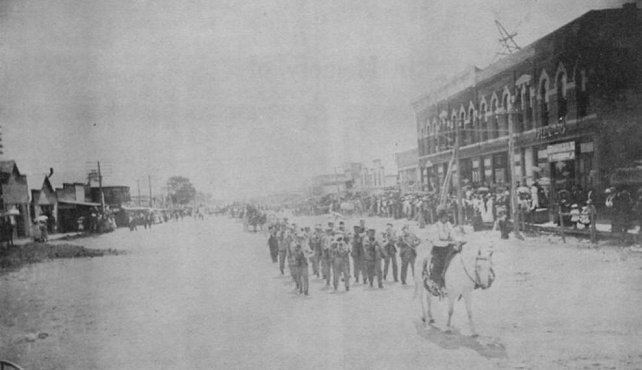
Early Day Parade at Coldwater.
A.H. BAKER
A.H. Baker was born in Wayne County, Missouri, 1841, and settled on government land near Protection in 1884. He was successful in farming and sheep raising. In 1904, with others, he organized the Protection State Bank. He was president for two years, when he sold his interests and bought the Peoples State Bank of Coldwater, of which he was also president.
=========== Page 62 ==========

PART OF THE COLDWATER GRADE AND HIGH SCHOOL BUILDINGS, 1959
COMANCHE COUNTY'S MORMON COLONY
In the fall of 1909 a Mormon Colony was established by the Monongahela, Pa., Church of Jesus Christ in the southeast part of Comanche County on 1,920 acres of land now owned by the McMoran Brothers. The population was not more than 50 at any one time, and each shared according to his needs.
This church had no affiliations with the Utah Church except its belief in the "Book Of The Mormons." It had strict laws against polygamy and forbade the marriage of whites and Negroes; otherwise it was about the same as other Protestant churches.
Many fine people of sincere Christian faith lived in this Colony, but due to unfamiliar environment, misfortune and discouragements the colony was closed out 1928.
JOHN TODD
John E. Todd, born on a farm in Marion County, Indiana, March 21, 1857. In 1882 he came to Kansas and bought land in Barber County and in 1884 came to Comanche County, locating on government land 10 miles south of Coldwater. Later he secured a large tract of land and entered the cattle industry on a large scale. Mr. Todd was the first county assessor of Comanche County. He held various township offices and in 1912 was elected a member of the Board of County Commissioners.
=========== Page 63 ==========
WILLIAM KIMPLE
William H. Kimple, veteran of the Civil War, was born in Phildelphia, October 3, 1844. In 1856, he went to Iowa to live with relatives. At the age of 18, he enlisted as a private in Company M. 3rd Regiment, Iowa's Cavalry. Served three years and fought in many battles, being one of the fortunate, was never seriously injured. On receiving an honorable discharge, he returned to Iowa. Then in 1884 came to Comanche County and entered the livery stable business, the pioneer stable of Coldwater. Also acquired land and always took an active part in the development of Comanche County. Mr. Kimple died in 1924.
GEORGE HENRY TORREY
George Henry Torrey was born in Syracuse, New York, and came to Comanche County in 1886. He filed on a claim six miles south of Coldwater, living in a dugout. He worked in Coldwater at his trade, that of a tinner. In 1880, he bought a hardware store, also carrying a line of wagons and carriages. Was very successful in business and accumulated quite a property, retiring in 1912.
=========== Page 64 ==========
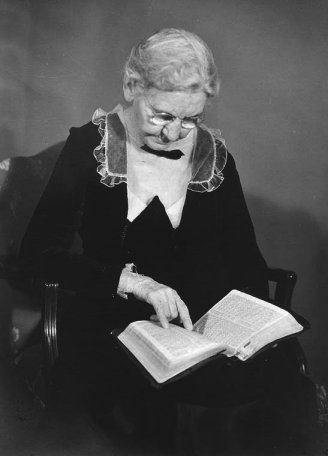
SOPHIA E. HOLMES
In February, 1927, the Bible Study Club was organized by Mrs. S. E. Holmes, using the Sunday School lessons for study. Under the guidance of Mrs. Holmes, the club grew and because of her inspirational and Christian life the members have organized other clubs in her honor.
The six clubs now organized are: Holmes Bible Study No. 1, Holmes Bible Study No. II, Holmes Bible Study No. III, Antioch Holmes Bible Study, Bangkok Thailand Bible Study and Holmes Bible Study No. IV.
Charter members were: Myrtle Betzel, Edna Brown, Hazel Carter, Mary Ann Daniel, Hazel Herd, Gertrude Oller, Eunice Schenk, Mrs. Holmes.
The first three years they studied the Sunday School literature of the churches. Mrs. Betzel was the first president. The present study used by the six Study Clubs is the Menninger Bible Course.
Mrs. Holmes of Coldwater, Ks. Photo by John Edward Schrock.
ABOVE PAGE SPONSORED BY THE SIX CLUBS
=========== Inside Back Cover ==========

THE MEMBERS of THE COLDWATER LIONS CLUB
EXTEND CONGRATULATIONS
As Coldwater Celebrates Its
DIAMOND JUBILEE
The Lions Club has not missed a weekly meeting since it was organized in April, 1927.
32 YEARS OF UNSELFISH SERVICE TO THE COLDWATER COMMUNITY
Thanks to Bobbi (Hackney) Huck for providing the information & images for this page.
Copyright © 1996 -
The USGenWeb® Project, KSGenWeb, Comanche County
This page was last updated
11/19/2024












 * REGISTERED HEREFORDS SINCE 1932
* REGISTERED HEREFORDS SINCE 1932 
























